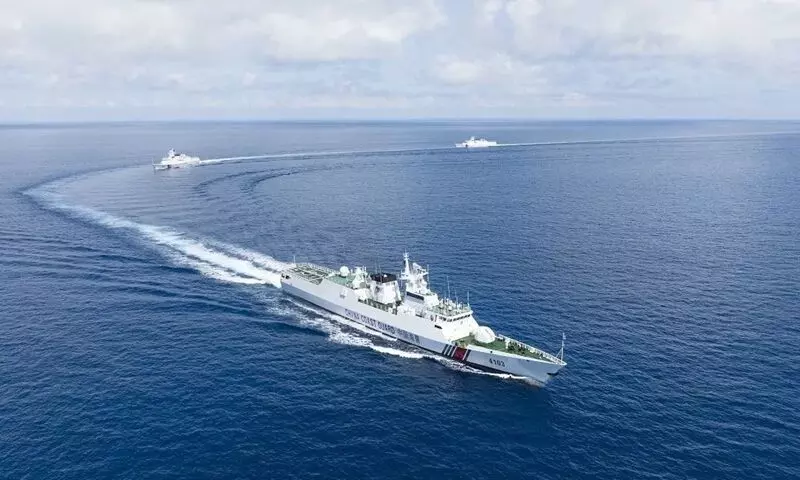Large presence of Chinese vessels in Indian Ocean region, India keeping close watch: Navy chief
Indian Navy is seized of the docking of various PLA Navy ships at ports in Pakistan, and it is "keeping a watch on it"
By Newsmeter Network
New Delhi: There is a "large presence" of Chinese vessels in the Indian Ocean Region and India keeps a "very close watch" on the developments in the region to protect and preserve its national interests in the maritime domain, Navy Chief Admiral R Hari Kumar said on Saturday.
During an interaction at a conclave here, he also said that the Indian Navy is seized of the docking of various PLA Navy ships at ports in Pakistan, and it is "keeping a watch on it".
Asked about the threat aspects, the Navy chief spoke of both conventional and non-conventional threats, besides those emerging from what he described as "silent and inclusive paradigm" resulting in a "web of threats" that are emerging.
Meanwhile, IAF Chief Air Chief Marshal V R Chaudhari in a separate interaction themed on 'Indian Air Force: The Future is Now', held at The Chanakya Conclave in Delhi, said in future what needs to be worked on is that besides the land-based offensive platforms, "we will have space-based offensive systems too".
This will lead to "reduced response time" and "greater effect" on adversaries, so the future lies in having "space-based offensive platforms," he said in response to a question from the audience on evolving military threats.
The IAF chief also said that the fundamental utilisation of space for military use is in three domains, including ISR (Intelligence, Surveillance and Reconnaissance) and communication, which have seen a "quantum jump" in their capabilities in the last several years.
After Air Chief Marshal Chaudhari's session, the Navy chief took part in a session on 'Indian Navy in the 21st Century: Evolving Maritime Threats'.
The Indian Navy's role is to protect, promote and preserve national interests in the maritime domain, wherever they are, and it assesses the threats and challenges, the Navy chief said.
On a daily basis, it is being seen that there is a certain amount of contestation happening at sea. It is well below the threshold of conflict, but possibility of a full-fledged war cannot be ruled out, the Navy chief said.
On a question on PLA Navy ships docking at ports in Pakistan, he said, these ships are docking at ports in various countries, and not just in Pakistan.
As far as their visit to ports in Pakistan are concerned, "we are seized of it, and keep a watch on it", he said.
Admiral Kumar said the Pakistan Navy is modernising itself at a "good pace" and seeks to become a 50-platform force in 10-15 years, and they are adding new corvettes and frigates to their fleet.
As far as China is concerned, in the last 10 years, a large number of ships and submarines have been commissioned by it, the third aircraft carrier is under construction, and much larger destroyers they are working on, he said, adding, "we feel this will plateau at some time".
"We are keeping a very close watch in the Indian Ocean Region... and effort is to know whose presence is there and what are they up to, and monitoring it 24x7, and we deploy aircraft, UAVs, ships, submarines, etc.," the Navy chief said.
"There is a large presence of Chinese vessels. At any point of time, there are 3-6 Chinese warships in the India Ocean Region," he said, adding some are close to the Gulf of Oman, and some in the eastern part of the IOR, among other places.
Chinese research vessels are ever present, numbering from 2-4 and Chinese fishing vessels as well. So, there is a large presence of Chinese vessels in the Indian Ocean Region, and India Navy keeps track of it, the Navy chief said.
"So, we refine our plans, actions that are required to be taken, and this also feeds into our capability development," the Navy chief said.
Later, in response to a query from audience on Chinese research vessels, Admiral Kumar said, these vessels have the ability to track and collect electronic signals.
When they operate, close to "our areas of national interest", the Indian Navy keeps an eye, and it has its ships which "monitor them very, very closely".
On a question on whether modernisation and capability development has any link with threat assessment, he said, modernisation is part of the process and not threat-driven.
And, a Navy has to be a "well-balanced force", so, it's not about nuclear submarine vis-a-vis aircraft carrier, as each of the two bring their own capabilities and they are "not either/or", Admiral Kumar said.
On Atmanirbhar Bharat, he reiterated that the Indian Navy has "committed to the national leadership that we (Navy) will be fully Atmanirbhar by 2047".
He added that as Indian economy is poised to grow in coming years, the volume of trade will multiply along with it, and hence the importance of role of Indian Navy will also grow.
He explained that there are three components to a naval asset -- float, move and fight.
In float component, about 95 per cent self-reliance has been achieved, while in move components which includes system propellers etc., it is about 65 per cent. And, in fight component, the figure is about 55 per cent, the Navy chief said.
Among other challenges, Admiral Kumar, also spoke of the region being prone to natural disasters, as also "non-combatant evacuations" which have been happening rather frequently.
Admiral Kumar underlined the challenge of cyber threat as well and "weaponisaion of cognitive domain" through largely use of social media.
Inputs from PTI